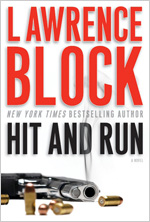Hit and Run

Based on an impressively large body of work and awards from people who care about such things, one can say Lawrence Block is a big thing in the crime story universe. But I came upon his work through a well-realized film, 8 Million Ways to Die by Hal Ashby (his last), based on Block’s Matthew Scudder character (of which there are at least a dozen novels in that series). Jeff Bridges gives one of his typically underappreciated performances as Scudder and Andy Garcia, as cocaine dealer Angel Moldonado, performs brilliantly with his nostrils—on par with Angelica Huston’s hip shaking in The Grifters.
Block’s most recent series features a hired killer, Keller, who lives alone in Manhattan with his large-screen TV, TiVo, and his life’s passion—his stamp collection—and receives his commissions through his best friend Dot. In Hit and Run, Keller is set up as the fall guy in the assassination of a rising political star, the black governor of Ohio. Block makes Keller’s law-avoidance odyssey back to Manhattan from Des Moines interesting. His detour through New Orleans presents faintly distinct flavor, especially since Keller manages to find himself saving a rape victim in a New Orleans park and subsequently 1) conjures a love relationship with the victim; 2) finds out his friend Dot’s name is really Dorothea; and 3) travels to Montana. A few people die, a baby is conceived, and Dot leaves Manhattan for Sedona, Ariz., and loses weight and changes her hair. She even shoots two Jehovah’s Witnesses in order to stage her own death more convincingly. Block does write well, but don’t look for the story to go very deep—for example, we never find out why Keller was set up—which I was able to forgive, but readers of a more orderly composition may see it as a lapse.
